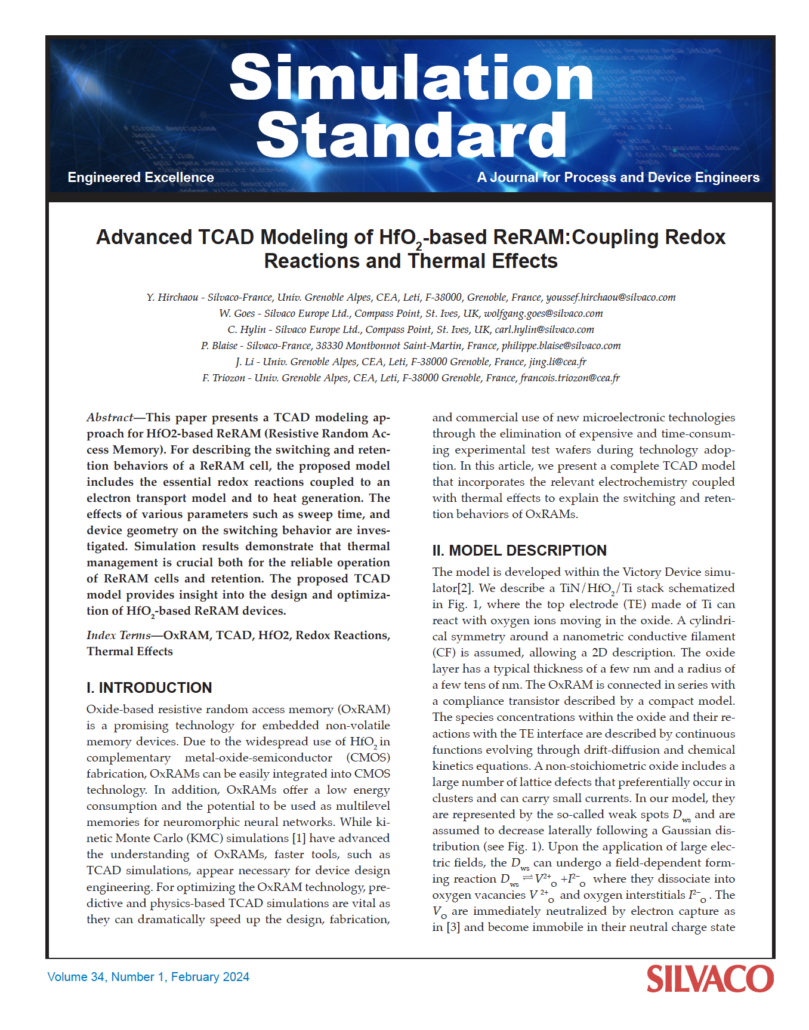Simulation Standard Technical Journal
A Journal for Process and Device Engineers

Advanced TCAD Modeling of HfO2-based ReRAM: Coupling Redox Reactions and Thermal Effects
This paper presents a TCAD modeling approach for HfO2-based ReRAM (Resistive Random Access Memory). For describing the switching and retention behaviors of a ReRAM cell, the proposed model includes the essential redox reactions coupled to an electron transport model and to heat generation. The effects of various parameters such as sweep time, and device geometry on the switching behavior are investigated. Simulation results demonstrate that thermal management is crucial both for the reliable operation of ReRAM cells and retention. The proposed TCAD model provides insight into the design and optimization of HfO2-based ReRAM devices.

Numerical Algorithm to Perform Viscoelastic Analysis
Numerical Algorithm to Perform Viscoelastic Analysis
Viscous materials exhibit both viscous and elastic characteristics when undergoing deformation. The response of such materials to force is characterized by two distinct phases. The materials first deform instantaneously akin to elastic materials. Following on, the material continues to deform at a relatively slower time scale. Typically, materials undergoing thermal treatment exhibit viscoelastic properties.

2023 TCAD Baseline Release
New Features in the 2023 Baseline Release:
- Section 1: Process Simulation – New Features in 2023 Baseline Release
- Section 2: Device Simulation – New Features in 2023 Baseline Release
- Section 3: Victory Mesh – New Features in 2023 Baseline Release
- Section 4: New Examples in 2023 Baseline Release

Simulation Framework for Device-packaging Co-design for Power Electronics
The past several years has seen a fast deployment of wide-bandgap power devices in fast chargers, electric vehicles, data centers and renewable energy processing. The performance of power devices is fast progressing towards their intrinsic material limit. As these devices can handle higher voltage and larger current density, packaging and thermal management will become the key limiting factor for exploiting their benefits in power electronic converters and systems.

Understanding of Geometrical Boundary Conditions in Victory Process
It is common to run the process simulation for the part of a larger structure just to reduce the computation time. To account for the influence of parts of the structure outside the simulation domain, Victory Process makes assumptions about overall structure geometry.

Automatic Grid Refinement for Thin Material Layer Etching in Process TCAD Simulations
The utilization of thin material layers is common in modern semiconductor device fabrication. Subsequent etching steps require an accurate modeling of these thin layers. Although level-set based process TCAD simulations are capable of representing flat thin material layers with sub-grid accuracy, topographical changes during etching processes expose the low underlying grid resolution, which leads to detrimental artifacts.

